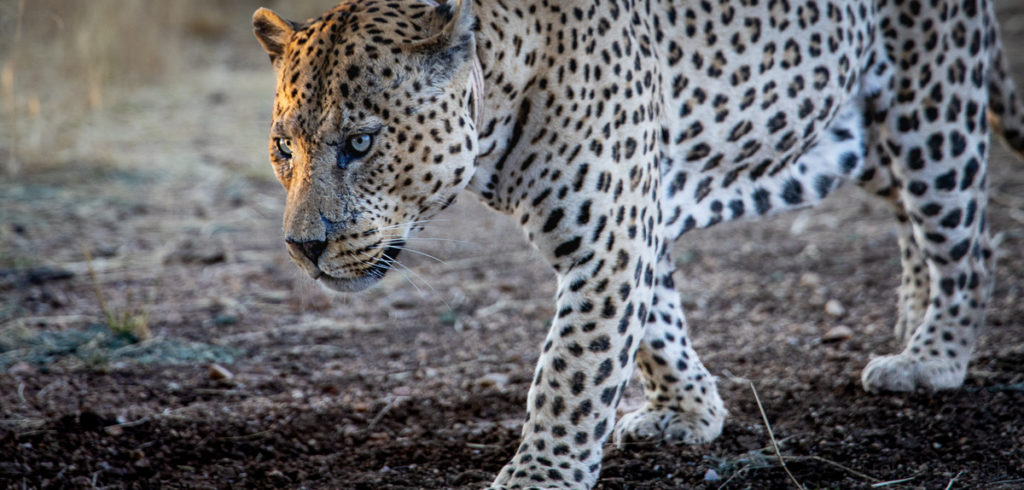You will discover surprisingly many leopards in the Okonjima Nature Reserve. That’s because the big cats have been reintroduced and protected in the 80 mile² private nature reserve in the north of Namibia. Read here about my close encounter with one of them!
Mindblowing leopard safari
The main attraction in Okonjima are the leopards. Since most of them were raised here in the fenced reserve, they each wear a radio collar.
With their direction-finding antennas the guides can track down individual leopards. It makes it much easier to find the well-camouflaged predators in the huge enclosure.
Today, Katja and I are out on a game drive with guide Opari.
Opari holds his antenna skyward every now and then and explains to us that the closer the leopards are, the louder the receiver’s radio signal will beep.
He can tell which animal it is by the receiver channel on which the incoming signal registers.
Aha… really now?
Well, I don’t hear anything!
But Opari gives it his all: He climbs onto the hood of his Land Cruiser, holds the antenna aloft and swings it in all directions.
Hold it! Now I too hear a chirping beep!
Opari (and I) climb back into the car. He races unerringly in the direction from which the antenna picked up the sound.
A few bends in the road later we spot him – a handsome, gracefully loping leopard!
That’s “our” leopard! He goes by the name Mawenzi!
Opari announces proudly. Mawenzi is a nine-year-old and weighs in at a hefty 183 pounds!
The predatory cat calmly crosses the road and disappears in the next thicket, which our safari jeep can’t penetrate.
Anticipating the cat’s next move, Opari drives our jeep to a clearing a short distance away where Mawenzi presumably will emerge from the thicket again.
And indeed, we soon spot the exquisite big cat again. What a beautiful specimen!
And now it gets even better because Mawenzi strides directly towards us. Those killer eyes – shivers run down my spine. No wonder the photos come out a little shaky!
But I make sure now to pull my hand with the camera back into the jeep, not to tempt Mawenzi to treat himself to a snack!
In case you are also fascinated by leopards: In my travel tips for Botswana’s Okavango Delta, you’ll find more photos and videos – among others, of a young, still rather clumsy leopard that fell from a tree and disappeared under our jeep!
More about the Okonjima Nature Reserve
Okonjima is located halfway between Namibia’s capital Windhoek and the spectacular Etosha National Park (see our Etosha travel tips here).
Okonjima was a cattle farm in the 1970s. But the predatory felines were constantly ravaging the cattle. The Hansen family, the owners, was powerless to stop the cattle carnage.
If you can’t fight them, join them: they became increasingly interested in the behaviour and habits of the big cats – and transformed Okonjima from a traditional cattle ranch into a nature reserve.
Okonjima – The AfriCat Foundation
Today, The AfriCat Foundation (external link) is based here, a non-profit organization dedicated to the protection and conservation of Namibia’s big cats, especially leopards and cheetahs.
Okonjima Bush Camp
Okonjima offers various lodges, camps, and a campground. We felt right at home! Here are our tips on the bush camp and its other safari offerings.
More pictures of Okonjima
Getting there
Okonjima is located halfway between Windhoek and Etosha National Park. The drive from Windhoek airport takes about 4 hours.
Take highway B1 to the nature reserve. It is a well-paved road both from the airport and from Etosha National Park.
From the reserve turn-off on the B1, it is about 12 miles on a gravel road to the bush camp lodgings.
We booked our accommodations and our whole trip through Rhino Africa. We highly recommend this travel agency!
Here you will find our travel tips for a Namibia circle tour as well as other reports of our adventures.
